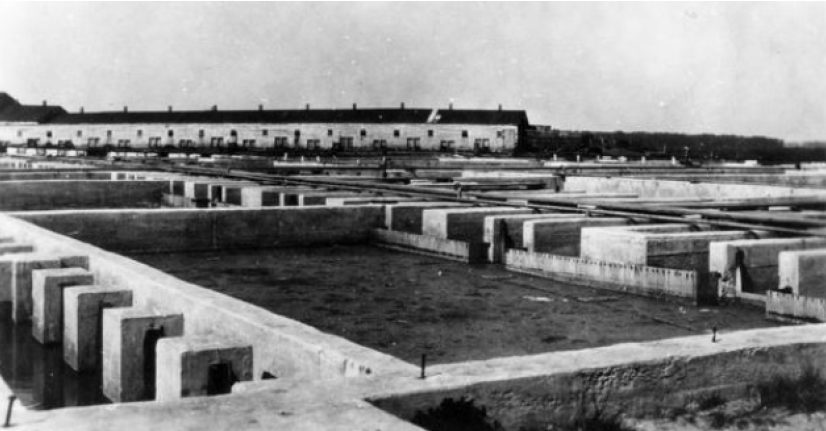“Flow of history: The Burke Plant” is the seventh article in a series outlining the history of wastewater treatment in Madison from the mid-1800s through 1914. Earlier articles are available in the History section of our blog, beginning the series with Flow of history: Early concerns prompted community action.
By Paul Nehm
Although the wastewater treatment plant that began operation in 1901 near the Yahara River had reached its design capacity in 1907, the City of Madison did not purchase land for a new treatment plant until 1911. The site was about two miles north of the existing plant and was located in the Town of Burke, near what currently houses Bridges Golf Course and Truax Field. Interestingly, the site was located next to a large pig farm owned by veterinarian Dr. J.P. West, who collected garbage from the City of Madison and fed it to his pigs.

To convey the wastewater to the new plant, two new pumping stations were built. The Greenbush Station was constructed in Brittingham Park near Chandler Street. It replaced a pumping station that was located on South Murray Street near Milton Street. The Greenbush Station pumped the wastewater from what was then the west and south sides of Madison through a force main across the isthmus, toward the old treatment plant.
The second new pumping station, called the Main Station, was built at the corner of North First Street and East Johnson Street, near the old treatment plant. The force main from the Greenbush Station connected to the force main from the Main Station just outside of that station. The combined force main conveyed the wastewater from the city to the Burke Plant.
The primary treatment portion of the Burke Plant was placed into service in 1914 and the trickling filter portion of the plant began operation in early 1916. Effluent from the plant flowed by gravity through an outfall to the Yahara River upstream of Lake Monona. The discharge of this water to the lake was felt by many residents to be the cause of significant odor issues in the lake. In response to these concerns, the Common Council commissioned a comprehensive study to be done on the cause of odors in the lake. Although the 1920 report from this study stated that decaying algae rather than the plant effluent was the cause of the odors, the public was not convinced.
The Burke Plant was designed for a flow of 5 million gallons per day (MGD), which was not expected to occur until 1930. However, by 1920 that rate of flow had already been reached. The average daily flow in 1922 was 6 MGD, rising to 6.8 MGD in 1927.
In 1924, Professor Charles I. Corp inspected a number of municipal treatment plants in Wisconsin for the State Sanitary Engineer. Although the Burke Plant was overloaded, his report placed the plant in a good light. With the exception of the Burke Plant, he found that all of the other plants had “more or less serious failure to properly function.” The Burke Plant’s ability to operate successfully under the overloaded conditions was probably due to the actions of its superintendent, James Mackin.
With the Burke Plant overloaded, the City had to decide if it was going to expand the plant or if it was going to build a treatment plant at another location. Eventually, a decision was made in 1923 to construct the Nine Springs Wastewater Treatment Plant. Until the Nine Springs Plant was completed in 1928, the Burke Plant continued to be overloaded and continued to discharge to Lake Monona, as it was not possible to discontinue the discharge of treated effluent to Lake Monona until the First Addition to the Nine Springs Plant was completed. With that addition, the Nine Springs Plant had enough capacity to treat the wastewater that the Burke Plant had been treating.
Editor’s note: The Burke Plant was retired from service on December 4, 1936. However, the Burke Plant returned to service the military installation at Truax Army Air Field during World War II. Between 1950 and the 1970s, Oscar Mayer Company took over operation of the plant as a pretreatment facility for their meatpacking wastes. The site is now owned by Madison Gas & Electric (MGE).
Much of the information for the article series was found in “Madison – A History of the Formative Years” by David V. Mollenhoff and in articles written by early leaders from Madison’s public works sector. The article was originally published in the Summer 2021 edition of the District’s newsletter, The Clarifier.






